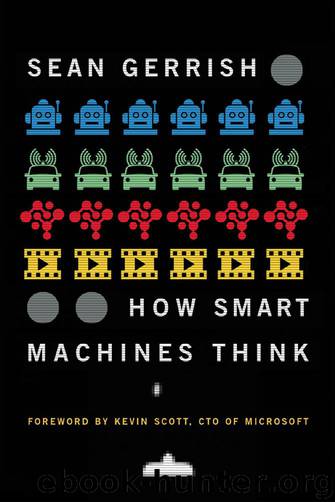How Smart Machines Think by Sean Gerrish & Kevin Scott

Author:Sean Gerrish & Kevin Scott [Gerrish, Sean & Scott, Kevin]
Language: eng
Format: epub
Tags: Computers, Intelligence (AI) & Semantics, Technology & Engineering, General, computer go, deep neural networks, search, artificial intelligence, regression, autonomous vehicles, how ai works, computer vision, clustering, ai, automata, overfitting, ibm watson, three-layer architecture, navigation, mechanical turk, deep learning, imagenet, statistical learning, alphago, Netflix grand prize, self driving cars, classification, matrix factorization, autonomous cars, computer art, search algorithms, speech recognition, reinforcement learning, starcraft bots, darpa grand challenge, neural networks, ml, recommendation engine, machine learning, computer perception
ISBN: 9780262038409
Google: 5iVyDwAAQBAJ
Amazon: 0262038404
Publisher: MIT Press
Published: 2018-10-30T06:00:00+00:00
OVERFITTING
One of the biggest challenges in fitting neural networks is that if the network is too flexible, or if we don’t have enough data to train the model, then we might learn a model that explains the training examples well but doesn’t generalize to other, unseen examples. We saw this same problem in chapter 6, about the Netflix Prize; this risk is called overfitting. What does overfitting look like in practice?
In figure 9.1a, I show a small sample of data. In this case, it’s just pairs of points, (input, output). Let’s say we want a model for these points that, given an input value, produces an estimate of the output value. This is exactly what you’re doing when you fit a neural network: you’re just fitting a model to predict some output values from the input values. And just below this, in figure 9.1b, is a model I’ve fit to these points. The model is the curvy line that goes through or near many of the points. From this model—the curvy line—you can see what it would predict for each input value, both for the inputs we had seen during training (the black dots) and for many values we hadn’t seen in training.
Figure 9.1
Plots to illustrate overfitting: (a) a sample of points (input, output) for which we hope to build a model; (b) a complex and overfit model of these points (the black curvy line); (c) a linear model of these points (the straight line); and (d) a complex but not overfit model of these points (the black, not-very-curvy line).
Download
This site does not store any files on its server. We only index and link to content provided by other sites. Please contact the content providers to delete copyright contents if any and email us, we'll remove relevant links or contents immediately.
Algorithms of the Intelligent Web by Haralambos Marmanis;Dmitry Babenko(16234)
Jquery UI in Action : Master the concepts Of Jquery UI: A Step By Step Approach by ANMOL GOYAL(9386)
Test-Driven Development with Java by Alan Mellor(7735)
Data Augmentation with Python by Duc Haba(7608)
Principles of Data Fabric by Sonia Mezzetta(7378)
Learn Blender Simulations the Right Way by Stephen Pearson(7294)
Microservices with Spring Boot 3 and Spring Cloud by Magnus Larsson(7137)
Hadoop in Practice by Alex Holmes(6587)
RPA Solution Architect's Handbook by Sachin Sahgal(6515)
The Infinite Retina by Robert Scoble Irena Cronin(6216)
Big Data Analysis with Python by Ivan Marin(5933)
Life 3.0: Being Human in the Age of Artificial Intelligence by Tegmark Max(5514)
Pretrain Vision and Large Language Models in Python by Emily Webber(4894)
Infrastructure as Code for Beginners by Russ McKendrick(4653)
Functional Programming in JavaScript by Mantyla Dan(4436)
WordPress Plugin Development Cookbook by Yannick Lefebvre(4382)
The Age of Surveillance Capitalism by Shoshana Zuboff(4245)
Embracing Microservices Design by Ovais Mehboob Ahmed Khan Nabil Siddiqui and Timothy Oleson(4148)
Applied Machine Learning for Healthcare and Life Sciences Using AWS by Ujjwal Ratan(4135)
